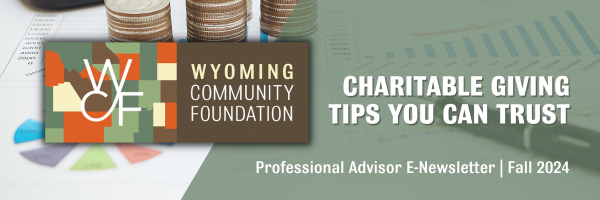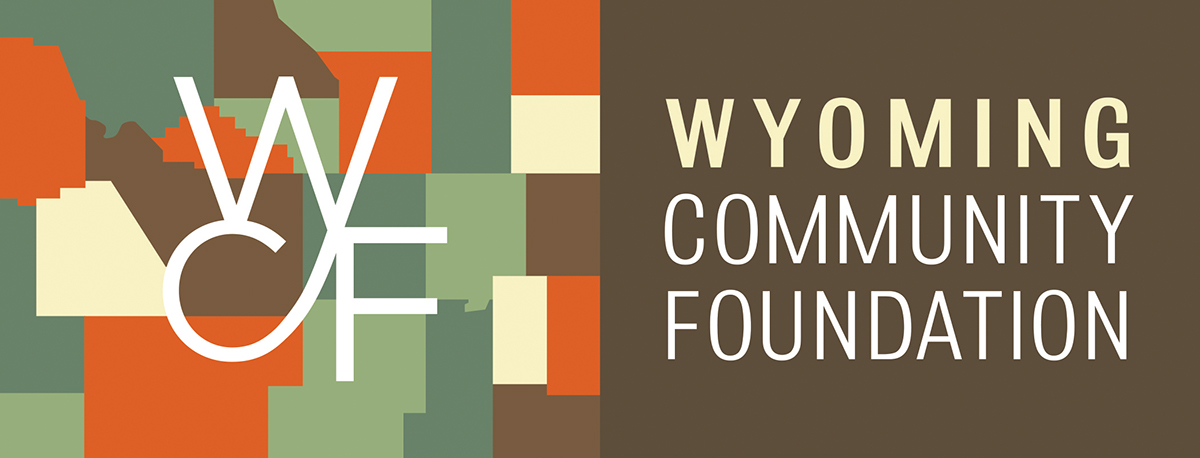
Tips You Can Trust: Smart Giving Strategies
Steps to Give Real Estate, Getting Ahead of Year-End Planning, and Locking in the Exemption
Greetings from the Wyoming Community Foundation!
The days are getting shorter! We’re already hearing from attorneys, CPAs, and financial advisors that you’re ready to get a jump on year-end charitable planning for your clients. Many thanks to those of you who have reached out!
In the spirit of staying ahead of the curve, we’re covering three topics this month that can help you as you begin to talk with clients about the remaining “must do” items for 2024, including charitable giving.
-
- Gifts of real estate to a fund at the Wyoming Community Foundation can work wonders for both the charitable causes your client supports as well as the client’s tax situation. Please reach out to WYCF to learn more about each critically important step in the process and how to comply with tax laws.
- Procrastination is a very common human reaction to tasks that seem daunting. Estate planning, tax planning, and financial planning can sometimes fall into this category. Unfortunately, clients who put things off for too long often find themselves missing out on opportunities to further their goals. The community foundation offers tips for using charitable giving as a “gateway” topic for bigger conversations about essential year-end planning.
- If it feels like the topic of the estate tax exemption sunset is heating up, you are right! More and more of your clients are becoming aware of the change in the law that is slated to occur at the end of 2025 unless legislation intervenes. Be sure you know the basics about how this change could impact your clients, including the ways charitable giving and the Wyoming Community Foundation can fit into smart planning.
Thank you for the opportunity to work together! We are grateful.
–Your friends in philanthropy, WYCF
Navigating Real Estate Gifts: Essential Steps for Advisors

We’re hearing from more and more attorneys, accountants, and financial advisors that your clients are expressing interest in giving real estate to charity. This is wonderful news!
You’re certainly aware that gifts of real estate to a fund at the community foundation, just like gifts of other long-term capital assets, can be extremely tax efficient. That’s because your client is typically eligible for a charitable deduction based on the fair market value of the property. Because the community foundation is a public charity, when it sells the donated property, the proceeds will flow into the fund free from capital gains tax.
To achieve the best tax outcome and overall charitable result, though, it’s critical to undertake a careful process along the general lines of the following (depending of course on the specific situation):
-
- First, determine that the real estate is a long-term capital asset (held for more than one year). That may sound obvious, but we’ve talked with advisors and their clients in the past about a potential gift of real estate and it turned out that the property was only recently purchased. The fair market value deduction (versus cost basis deduction) is available only for a long-term capital asset.
-
- Next, you’ll want to work with the team at WYCF to structure a donor-advised or other type of fund to receive the asset, if your client does not already have a fund in place. The deductibility rules are different for real estate gifts to a public charity (such as a fund held at WYCF) versus a private foundation. Again, clients may not be aware of the pitfalls here. Sometimes we meet with advisors whose clients are very close to transferring real estate to a private foundation, which could be devastating in terms of missed tax savings.
-
- Verify that the property is not subject to a mortgage or other debt. Transferring encumbered property triggers important considerations with potentially significant tax consequences. The lender might not even allow a transfer in the first place. If you’re dealing with commercial property, you’ll also need to check to be sure that the property is not subject to “recapture” if your client has previously taken depreciation deductions.
-
- You will need to determine whether the property produces income and discuss this with the our staff. Income-producing real estate can potentially trigger “UBIT” (unrelated business income tax) for WYCF. Although there are exceptions and strategies to minimize UBIT’s impact, it’s important that this issue be dealt with up front.
-
- You may need to work with the Wyoming Community Foundation to determine whether an environmental audit is required for the property.
-
- Then, verify that the client has not entered into any discussions about an imminent sale of the property.
-
- Even if WYCF will sell the property shortly after receipt (so that the proceeds can flow into the donor-advised or other fund to support the client’s favorite causes), your client cannot have pre-arranged this sale. Doing so could trigger the IRS’s step transaction doctrine and wipe out the tax deduction.
-
- Importantly, ensure that the client obtains a qualified appraisal to determine the fair market value of the property. This is critical to obtain a tax deduction, and the appraised value must be reported to the IRS on a Form 8283 in strict compliance with the IRS’s rules.
-
- Finally, transfer the property with the appropriate legal documents, including a deed.
Whew! That’s a lot! The bottom line here is that gifts of real estate can be a wonderful tool for both your client and the charities they want to support through their fund at the community foundation. Our team can help you through the process, every step of the way. We have professionals in house, as well as on-call experts with whom we work regularly, to ensure that your client’s real estate gift is handled without a hitch, opening the door to bring their charitable goals to life.
Using Charitable Planning to Motivate Year-End Client Conversations
 As the year begins to wind down, consider tapping into your clients’ philanthropic interests as a catalyst to motivate them to start addressing year-end planning items right now rather than waiting until November or December. You may discover that the uplifting topic of philanthropy makes it easier to at least start a conversation. Then, the conversation can evolve to include not only charitable giving topics, but also other tax planning topics that need attention.
As the year begins to wind down, consider tapping into your clients’ philanthropic interests as a catalyst to motivate them to start addressing year-end planning items right now rather than waiting until November or December. You may discover that the uplifting topic of philanthropy makes it easier to at least start a conversation. Then, the conversation can evolve to include not only charitable giving topics, but also other tax planning topics that need attention.
Here’s how this could work with a client:
- Review the charitable components of the client’s estate and financial plans, including provisions in wills and trusts, beneficiary designations, donor-advised funds, prior years’ tax deductions, and historical gifts to favorite charities.
- Reach out to the client to suggest that you meet–or at least jump on a call–to check in on 2024 charitable giving plans and other items.
- Open the conversation by briefly recapping the charitable planning components already in place and the client’s history of giving. Then ask the client about their plans for 2024.
- As you talk with the client about charitable intentions, bring up various charitable giving tools and opportunities that match those intentions. In each case, use the charitable discussion as a springboard for general tax planning items that need to be addressed before year-end.
- For example, if a client who is over 70 ½ mentions wanting to support a particular need or organization in the community, you can suggest that you loop in the community foundation team to potentially establish a field-of-interest or designated fund, which can then receive distributions from the client’s IRA up to $105,000 annually per spouse. This, in turn, opens the door to discuss Required Minimum Distributions and other elements of retirement planning in general.
- If the client mentions that they are already dreading gathering tax receipts for 2024 charitable donations, suggest that the client consider setting up a donor-advised fund at the community foundation to serve as a convenient and rewarding “hub” for charitable giving. Going forward, the client can conduct the bulk of their giving using the donor-advised fund and avoid the mad scramble for receipts. If the client already has a donor-advised fund, make sure they know how to use it most effectively, and reach out to the community foundation team for help. What’s more, discussing charitable donation receipts presents a nice opening to remind a client about other paperwork that may need to be gathered or completed to meet overall estate and financial planning goals.
- When your client talks about charities they plan to support before year-end, remind your client not to automatically reach for the checkbook. Most of the time, highly-appreciated marketable securities (or other highly-appreciated, long-term assets) are ideal gifts to a client’s fund at the community foundation or other public charity because the client is eligible for a tax deduction at the assets’ fair market value, and the proceeds from the sale of the assets will flow into the client’s fund at the community foundation free from capital gains tax. That means more funds are available to support the client’s favorite causes. Conveniently, the conversation about highly-appreciated stock can segue naturally into a conversation about overall stock positions.
- Philanthropy topics can naturally lead into even more topics that are sensitive to year-end timing, such as annual exclusion gifts, estimated tax planning, and updating wills and trusts before the extended family gathers for the holiday or travels together overseas.
Our WYCF team is here to help you serve your charitable clients every step of the way, every month of the year. We understand that late-December transactions are often unavoidable. The net-net is that we’re happy to work with you according to your clients’ schedules, whether that means getting a jump on a new year and processing stock gifts in February, helping you plan in September for year-end, or preparing fund agreements in December. It’s our pleasure to assist!
Planning for a Sunset: Lock in a Higher Exemption, Unlock a Legacy
Without legislation to prevent it, the sunsetting of current estate tax laws at the end of 2025 will dramatically reduce the federal estate tax exemption from $13.61 million per person in 2024 to approximately $7 million in 2026 (this includes adjustments for inflation). This change would affect many high net-worth individuals and families, likely exposing many more estates to federal estate taxes.
It is impossible to predict whether or not legislation will prevent the sunset. Even so, it is important for advisors to prepare for client discussions and start considering estate planning strategies now, especially techniques that incorporate multi-generational gifts and charitable planning.

Indeed, for a client who is charitably-inclined, making larger lifetime gifts to charity and arranging for charitable bequests will help reduce the client’s taxable estate because of the charitable estate and gift tax deduction. Donor-advised, field-of-interest, designated, unrestricted, and endowment funds at the Wyoming Community Foundation are flexible and effective charitable recipients of both lifetime and estate gifts.
For some clients, you may wish to begin exploring a comprehensive, multi-generational wealth transfer plan, potentially using key tax-planning vehicles:
Charitable lead trust
Charitable lead trusts (CLTs) may be particularly effective in the current environment. These trusts can provide income to your client’s fund at the community foundation for a set period of time, with the remaining assets passing to family members. Right now, the higher exemption allows for potentially significant initial funding of such trusts. This is because the value of the remainder interest counts toward the client’s estate and gift tax exemption.
Generation-skipping trust
A generation-skipping trust is an irrevocable trust that can benefit a client’s grandchildren and later generations. This trust utilizes a client’s generation-skipping transfer (GST) tax exemption (which parallels the estate and gift tax exemption). This type of trust could allow a client to take advantage of the higher exemption before it potentially decreases in 2026. It is possible under some states’ laws for these trusts to go on for many generations in a “dynasty” format, such that each generation benefits from the trust’s income (and potentially principal for health and education) without the trust’s assets being included in the beneficiaries’ estates for estate tax purposes.
Multi-generational fund at WYCF
Alongside a charitable lead trust or generation-skipping trust, or as a standalone, a client can establish a donor-advised fund at the Wyoming Community Foundation that can function much like a family foundation, with successive generations serving as advisors, or the community foundation stepping in after the first or second generation, to recommend grants from the fund to carry on a tradition of supporting the causes that have been most important to the client during the client’s lifetime.
The team at the Wyoming Community Foundation looks forward to working with you to achieve your clients’ long-term charitable goals, even in the midst of uncertainty concerning the estate tax laws.
The team at the Wyoming Community Foundation is a resource and sounding board as you serve your philanthropic clients. We understand the charitable side of the equation and are happy to serve as a secondary source as you manage the primary relationship with your clients. This newsletter is provided for informational purposes only. It is not intended as legal, accounting, or financial planning advice.
